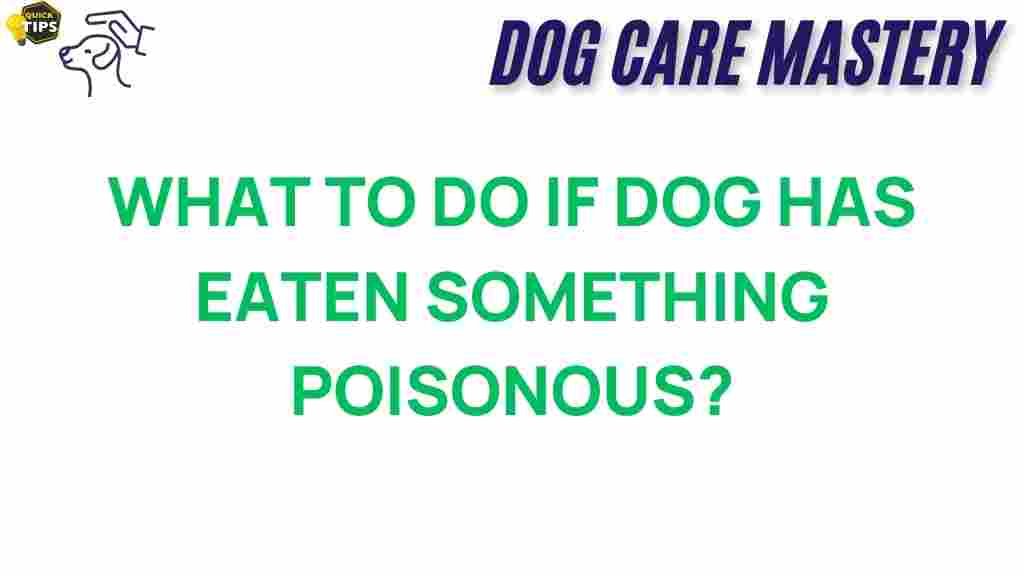What to Do If Your Dog Has Consumed Poisonous Substances? – Prioritizing Dog Health
As a devoted dog owner, ensuring your furry friend’s safety and well-being is paramount. One of the most alarming scenarios you may face is when your dog consumes poisonous substances. Whether it’s household chemicals, certain plants, or human foods, understanding what to do in such a situation is crucial for maintaining your dog’s health. This article will guide you through the immediate actions to take, how to assess the situation, and when to seek professional help.
Understanding Common Poisons for Dogs
Before diving into what to do if your dog has ingested something harmful, it’s important to recognize common poisons that can affect dog health:
- Human Foods: Foods like chocolate, grapes, onions, garlic, and xylitol (a sugar substitute) are highly toxic to dogs.
- Household Chemicals: Cleaning supplies, antifreeze, and certain pesticides can be lethal.
- Plants: Many common plants such as lilies, azaleas, and sago palms can be very dangerous.
- Medications: Over-the-counter and prescription medications intended for humans can cause serious health issues in dogs.
Immediate Steps to Take
If you suspect that your dog has ingested a poisonous substance, follow these steps to ensure their health and safety:
1. Stay Calm
Panicking can make the situation worse. Stay composed so you can think clearly and act quickly.
2. Identify the Poison
If possible, determine what your dog has consumed. Knowing the specific toxin can help veterinary professionals provide the right treatment. Look for:
- Empty containers or wrappers
- Plant parts or leaves
- Medications or supplements
3. Assess Your Dog’s Condition
Monitor your dog for any symptoms of poisoning. Common signs include:
- Vomiting or diarrhea
- Seizures
- Lethargy or weakness
- Difficulty breathing
- Excessive drooling
4. Contact Your Veterinarian or Poison Control
Reach out to your veterinarian immediately. If they are not available, contact a pet poison hotline. The ASPCA Animal Poison Control Center is a reliable resource, reachable at www.aspca.org.
5. Follow Professional Guidance
Provide your vet with as much information as possible about the substance ingested, the amount, and the time of ingestion. They will give specific instructions, which may include:
- Bringing your dog in for treatment
- Inducing vomiting at home (only if instructed)
- Giving activated charcoal to absorb toxins (if recommended)
Inducing Vomiting: When and How
In some cases, inducing vomiting may be necessary to prevent further absorption of the poison. However, this should only be done under the guidance of a veterinarian. Here’s how it is typically done:
- Hydrogen Peroxide: If advised, your vet may recommend administering 3% hydrogen peroxide. The usual dosage is 1 teaspoon per 10 pounds of your dog’s weight, but do not exceed 3 tablespoons.
- Timing: Inducing vomiting is most effective within 1-2 hours of ingestion.
Never induce vomiting if your dog is unconscious, having seizures, or if they ingested a caustic substance (like bleach) or a petroleum product.
What to Expect at the Vet’s Office
If your veterinarian decides that your dog needs to be seen, prepare for the following:
- Physical Exam: The vet will conduct a thorough exam to assess your dog’s condition.
- Diagnostic Tests: Blood tests, urine tests, or imaging may be performed to evaluate the extent of poisoning.
- Treatment: Depending on the type of poison, treatment may include intravenous fluids, medications to counteract the poison, or other emergency treatments.
Long-term Effects and Monitoring
After an emergency, it’s essential to monitor your dog for any lingering effects. Some poisons can cause long-term health issues. Regular vet check-ups and open communication about any unusual behavior can help catch problems early.
Prevention Tips for Dog Health
Preventing poisoning is the best approach for maintaining your dog’s health. Here are some effective strategies:
- Secure Hazardous Substances: Keep chemicals, cleaners, and medications in locked cabinets out of your dog’s reach.
- Educate Yourself: Familiarize yourself with plants that are toxic to dogs and remove them from your home and yard.
- Create a Safe Environment: Ensure that your dog’s play area is free from potential hazards.
- Use Pet-Safe Products: Choose non-toxic cleaning and gardening supplies.
What to Do in Non-Emergency Situations
Sometimes, your dog may consume something questionable but may not show immediate signs of distress. In such cases:
- Observe your dog closely for any changes in behavior or health.
- Keep a record of what they consumed and any symptoms that arise.
- Consult your veterinarian for advice, especially if you are unsure about the safety of the item.
When to Seek Emergency Care
It’s important to recognize when a situation has escalated to an emergency. Seek immediate veterinary care if your dog experiences:
- Severe vomiting or diarrhea
- Difficulty breathing
- Seizures
- Unconsciousness or extreme lethargy
- Unusual behaviors, such as aggression or disorientation
Conclusion
Being a responsible dog owner means being prepared for emergencies, including instances of poisoning. By knowing the common toxins, understanding the immediate steps to take, and maintaining a preventative approach, you can greatly enhance your dog’s health and safety. Remember to always have the contact information for your veterinarian and a poison control hotline readily available. Your vigilance and quick response can make a significant difference in your dog’s well-being.
For more information on maintaining your dog’s health, visit our dog health resources.
This article is in the category Safety and created by dogcaremastery Team
